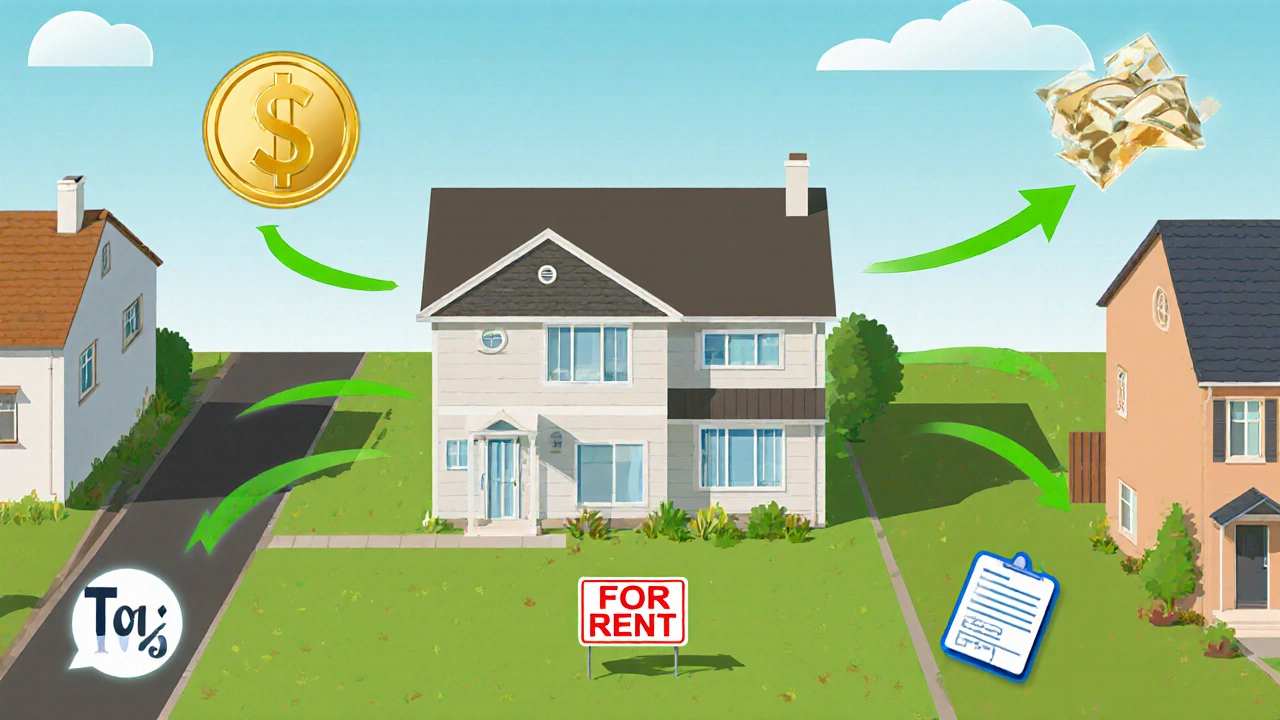Are Millionaires Made Rich by Real Estate?

Real Estate Investment Calculator
Calculate Your Real Estate Investment Potential
See how property value appreciation, rental income, and leverage can impact your returns
Based on the article's data: Real estate accounts for 40% of U.S. self-made millionaires' wealth sources. The calculator shows how leverage and appreciation impact returns.
Low RiskTip: The article notes that residential real estate offers better accessibility for first-time investors, while commercial properties typically yield 20% more NOI.
When you hear the term real estate millionaires, you probably picture a person who built a fortune buying Real Estate is a sector that includes land, residential and commercial properties, and it generates income through rent, appreciation, and development. Millionaire refers to an individual whose net worth equals or exceeds one million units of a given currency, typically measured in US dollars. But is real estate really the main engine behind most of their wealth? This article breaks down the data, explains how property creates cash, and separates myth from reality.
Key Takeaways
- About 40% of U.S. self‑made millionaires cite real estate as a primary wealth source, according to the 2024 Forbes Wealth Survey.
- Residential property accounts for roughly half of that share, while commercial assets contribute the other half.
- Leverage, tax‑benefits, and steady cash flow make real estate attractive, but market cycles and management overhead are real risks.
- Business ownership and stock market investments together still out‑perform real estate in total millionaire counts.
- Diversifying across asset classes remains the safest path to long‑term wealth.
How Millionaires Build Wealth: The Bigger Picture
Before zeroing in on property, it helps to see where millionaires get rich overall. The 2024 Forbes list, combined with data from the U.S. Census Bureau and the National Association of Realtors, shows the following rough split among self‑made millionaires:
| Source | Percentage | Typical Annual Return |
|---|---|---|
| Business Ownership | 35% | 12‑18% |
| Real Estate | 40% | 8‑12% (incl. leverage) |
| Stocks & Mutual Funds | 20% | 7‑10% |
| Inheritance | 5% | Varies |
Notice that ‘Real Estate’ aggregates both residential and commercial holdings, each with its own dynamics. The next sections unpack how those two sub‑markets generate wealth.
Residential Property: The Crowd‑Pleaser
Residential homes are the entry point for most new investors. They benefit from three core income streams:
- Rental Income is the cash you collect each month from tenants. In high‑demand cities like Auckland, median rents grew 6.4% year‑over‑year in 2023, according to the New Zealand Rental Index.
- Capital Gains arise when you sell the property at a higher price than you bought it. Over the past decade, median home prices in the U.S. rose about 70%, delivering robust long‑term appreciation.
- Tax advantages, such as mortgage interest deductions and depreciation, shrink your taxable income and boost net returns.
Leverage amplifies gains. A typical 20% down‑payment on a $500,000 home lets an investor control a $500,000 asset with only $100,000 of cash. If the property appreciates 5% annually, the investor sees a 25% return on the cash invested, before taxes.

Commercial Property: The Power Player
Commercial real estate (CRE) includes office towers, retail strips, warehouses, and industrial parks. It’s often the domain of seasoned investors and institutions because of larger capital requirements and more complex lease structures.
Key ways CRE builds millionaire wealth:
- Long‑Term Leases provide predictable cash flow. Ten‑year net‑lease agreements are common, shifting operating expenses to tenants.
- Higher Yield - Commercial cap rates typically range from 5% to 8%, compared with 3% to 5% for residential rentals.
- Value‑Add Strategies: Investors buy under‑performing buildings, renovate, and re‑lease at higher rents, often boosting NOI (Net Operating Income) by 20% or more.
Because CRE deals are larger, investors often pool capital through private equity funds or Real Estate Investment Trusts (REITs). REITs let individuals own fractional shares of commercial portfolios, receiving dividend payouts that can exceed 4% annually.
Leverage and Tax Benefits: The Hidden Engine
Both residential and commercial investors rely on borrowed money to magnify returns. The magic lies in the spread between the mortgage rate and the asset’s yield.
For example, if a loan costs 5% and the property yields 9%, the net spread is 4% on the entire asset value, not just the equity. Over time, as you pay down principal, your equity grows while the spread remains.
Tax wise, the following rules matter:
- Depreciation lets owners deduct a portion of the building’s value each year, lowering taxable income even while cash flow stays positive.
- 1031 Exchanges (U.S.) permit deferment of capital gains taxes when swapping one investment property for another, enabling continuous wealth compounding.
- In New Zealand, the “bright‑line” test on property sales applies after two years, meaning short‑term flips can trigger tax, but long‑hold investors avoid it.
Risks and Common Misconceptions
Real estate isn’t a guaranteed ticket to millionaire status. Here are the pitfalls that trip up many hopeful investors:
- Market Cycles - Property values can plunge during recessions. The 2008 U.S. housing crash wiped out $1.5 trillion in household wealth.
- Liquidity - Unlike stocks, selling a property can take months, limiting your ability to react quickly to financial needs.
- Management Overhead - Landlords must handle maintenance, tenant disputes, and vacancy periods. Unforeseen expenses can erode cash flow.
- Leverage Fatigue - High debt ratios increase vulnerability to interest rate hikes. A 2% rise in rates can turn a positive cash‑flow property negative.

Why Some Millionaires Still Prefer Other Assets
Even though real estate contributes heavily, many high‑net‑worth individuals lean on business ownership and equity markets for speed and scalability. Starting a tech company, for example, can turn a few hundred thousand dollars into billions within a decade-something most property deals can’t match.
Nevertheless, property offers a tangible, inflation‑hedging asset that many investors use to preserve wealth once they’ve already accumulated capital elsewhere.
Practical Checklist for Aspiring Real‑Estate Millionaires
- Define your investment horizon: short‑term flips vs. long‑term hold.
- Calculate your maximum leverage based on cash flow, not just purchase price.
- Research local market fundamentals: employment growth, population trends, and zoning changes.
- Factor in all costs: property taxes, insurance, management fees, and reserve funds.
- Consider diversification: mix residential, commercial, and REIT exposure.
Frequently Asked Questions
Do most millionaires get rich *only* from real estate?
No. While about 40% of self‑made millionaires list real estate as a primary source, the majority combine it with business ownership, stock investments, or inheritance. Real estate is often a major pillar, not the sole one.
Is residential property more profitable than commercial?
Profitability depends on your risk tolerance. Residential rentals are easier to manage and require less capital, but commercial properties usually offer higher yields and longer leases. Many investors start residential, then graduate to commercial.
How much leverage is safe for a first‑time investor?
A common rule is to keep the loan‑to‑value (LTV) at or below 70% and ensure the property’s cash‑on‑cash return stays above 8% after debt service. This buffer protects you against vacancy and rate hikes.
Can I invest in real estate without buying a physical property?
Yes. REITs, real‑estate crowdfunding platforms, and mortgage‑backed securities let you gain exposure to property markets with lower capital requirements and higher liquidity.
What tax strategies help keep more of my rental profits?
Take advantage of depreciation, claim mortgage interest, and, where applicable, use 1031 exchanges to defer capital gains. In New Zealand, holding a property beyond the bright‑line period (two years) avoids tax on appreciation.









Write a comment